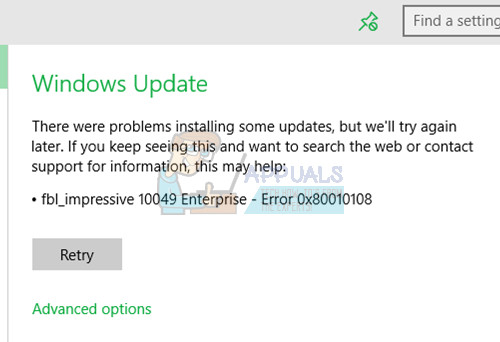How to Fix Windows Update Error 0x80010108
Some Windows 10 users are receiving a Windows Update error 0x80010108 when trying to check for new updates. There’s very little success when you use Windows Update troubleshooter and resetting Windows Update components, but it’s worth the try. This error occurs when there’s an error with the Windows Update service and it’s associated wups2.dll file.
This issue can be solved by trying a manual upgrade using an installation media and restarting the Windows Update service and then re-registering wups2.dll.

Method 1: Restarting the Windows Update service
- Launch the command prompt with elevated privileges typing cmd in the Start Menu, right-clicking on Command Prompt and selecting “Run as administrator”. Or you can press Windows + X and then select Windows Powershell (Admin). Accept the UAC prompt when it appears.
- Type this command in the command prompt.net stop wuauserv
net start wuauserv - Try to run Windows Updates again to see if the problem has stopped. If it still persists, move to Method 2 and then try again.
Method 2: Re-registering wups2.dll
- Launch the command prompt with elevated privileges typing cmd in the Start Menu, right-clicking on Command Prompt and selecting “Run as administrator”. Or you can press Windows + X and then select Windows Powershell (Admin). Accept the UAC prompt when it appears.
- Enter the following command in the command promptregsvr32 wups2.dll /s
- Reboot your PC and check for new updates again to see if the problem has stopped.
Method 3: Uninstalling your Antivirus
Apparently, uninstalling your antivirus and firewall tools is likely to solve the issue. It’s not sufficient to deactivate your antivirus. You can use a removal tool provided by your vendor to completely remove installed files and registry settings. For some users, McAfee caused the trouble and for other users, BitDefender’s Autopilot was the culprit.
- These are some AV removal tools. Using your browser, download the removal tool from your antivirus software using the links below.
- Launch the downloaded utility and follow its prompts to completely remove the anti-malware application from your system.
- Reboot your PC.
- After performing the upgrade, you can reinstall your antivirus.
Method 3: Repair Install
This is your last resort to fixing this problem. The instructions to perform a manual upgrade are here.
Other Fixes
You can try the Windows 10 update troubleshooter, check your date and time, disable your VPN software or proxy server and finally typing ipconfig /flushdns in the Windows command prompt window.